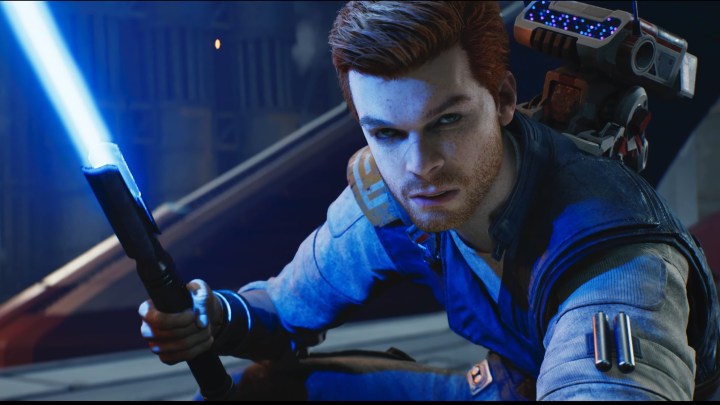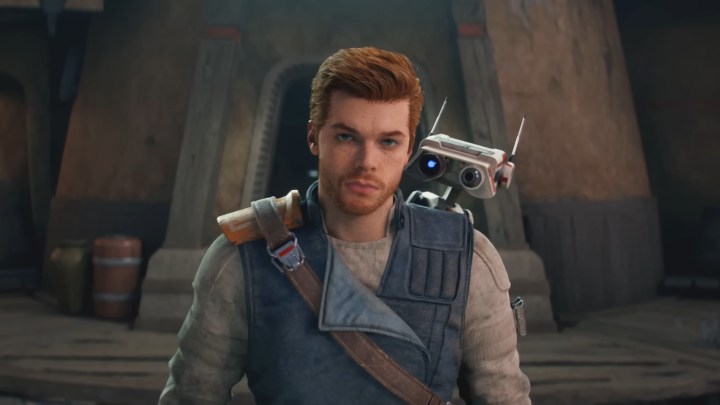It’s funny to think about how much has changed about Star Wars since EA released Star Wars Jedi: Fallen Order in 2019. The action-adventure game would launch just weeks before The Star Wars: The Rise of Skywalker, a polarizing conclusion to its sequel trilogy that would create a disturbance in the force. In the years since, Disney has entirely changed its approach to the series by expanding the cinematic universe with a mixed bag of content, from the critically acclaimed Andor to more middling projects like The Book of Boba Fett. More than ever, the series is in desperate need of stability. It’s somewhat fitting, then, that Star Wars Jedi: Survivor could be the project that gets Star Wars back on track.
During a demo event ahead of the sequel’s April 28 release, I got to play a sizable chunk of the game – spanning over three hours of playtime. What stood out most during that session wasn’t its visual glow-up or fleshed-out combat. Rather, it was how tightly packaged it all is, both as a AAA video game and as a piece of Star Wars media. It’s an almost classic Jedi adventure, filled with dramatic lightsaber battles and some lighthearted comedy in-between the galactic melodrama. It’s hard to imagine anyone being upset over it (though the fan base always finds a way, doesn’t it?).
Based on what I’ve played, Star Wars Jedi: Survivor is in excellent shape ahead of its launch later this month. More open-ended exploration, a better sense of reward, and revitalized combat already have me feeling like it’ll be a top-tier Star Wars experience – one that could make a strong case for the series to move from a film and TV focus to a video game one.
Kestisvania
My demo begins about an hour into the full game, as Cal Kestis and his droid pal, BD-1, crash land on a planet called Koboh. I won’t get into story details (mostly due to some convoluted restrictions on what I can discuss), but the slice I played teased a rather sprawling epic with crisscrossing plot threads. My mission to repair my broken-down ship takes me through a mining ghost town, where I cross paths with the nefarious Rayvis. That’s just the tip of the iceberg, as I leave my session with a notepad full of character names and historical lore to pore over.

There’s a lot to unpack there, but my primary focus winds up landing on how the sequel approaches exploration. Like its predecessor, Survivor is a bit of a genre mash-up that takes the bonfire checkpointing of Dark Souls and smashes that into a light Metroidvania where secrets are locked behind gear upgrades (I’d find a rather direct reference to Super Metroid during my session, as some helpful animals showed me how to wall jump). Survivor retains all of the basics, with an emphasis on traverse tools like wall-running and puzzle-solving force powers.
The difference, though, is that the slice I played is significantly more open-ended. When I arrive at a cliffside vista early on, I use BD-1 as a pair of binoculars and start placing markers around the map. Rather than rushing to the main objective, I spend a good 45 minutes poking my head into various alcoves to find hidden chests, collectible seeds, and small side areas where I fight through a patrol of Stormtroopers to claim some rewards. It feels much more like a true Metroid game in some way, as there’s a ton of space for me to get lost in. It’s not a full open world, but Koboh already hits that smaller sweet spot that games like Uncharted: The Lost Legacy have proven works just as well.
There’s some significant side content nestled in the world too. When I stop to chat with a miner in Koboh’s main town, I follow a rumor into an abandoned cave. My quest to find out what happened to some missing workers culminates in a battle against a Rancor, the most thrilling and challenging fight I come across during my session. Other side content has me solving some clever environmental puzzles to find health or Force upgrades. Thankfully, the sequel features fast travel this time, which makes it much easier to follow up on a tricky secret later. I spent half my demo stumped about how to break a vine-tangled wall, only to have a eureka moment later and quickly teleport back to solve it with my force powers and a wandering bomb droid.

What’s most notable about the structural change is how much more rewarding exploration feels. That was a weak point of Fallen Order, as hidden passages would grant Cal a few lightsaber parts and some hideous ponchos. Developers I spoke to at the event noted that customization was a last-minute addition in Fallen Order, which is why its scope was so limited. For Survivor, the team went into the project knowing that would be a focus, which makes a world of difference.
By the end of my demo, I had discovered a wealth of clothing, hairstyles for Cal, BD-1 parts, lightsaber components, and color sets that would let me give just about everything my own sense of style. Cal was rocking a killer mullet and a purple-and-chrome lightsaber hilt by the time I was done with him.
The only potential pain point I come across is in environmental legibility. Survivor bucks some generic video game trends, opting not to splash climbable objects in flashy yellow paint. Level design is more natural as a result, with Cal scurrying up metal grates or shimmying around on vines as he wanders. I did hit a few moments, though, where I simply wasn’t sure where to go as I missed a subtle visual cue or didn’t realize that a detailed piece of the environment was climbable.
That’s about the closest thing my session had to a red flag, though – and it’s so light that it’s nearly pink. I’m impressed by the bigger scope overall, as it allows the designers at Respawn Entertainment to build out more intricate worlds that weave platforming, puzzle-solving, and stray battles together naturally. I could have spent at least another hour smoothly wall-running across chasms and climbing up to secret nooks. Not a moment of my time felt wasted.
Pick your stance
Combat gets a similarly impactful overhaul here too. The core is still the same, with Cal slashing, parrying attacks with his lightsaber, and using his force powers to push and pull enemies. The difference is that he now has five different stances he can choose from (he can equip two at a time, switching them out at meditation sites). In my demo, I’d get to try out three of those, including his basic lightsaber stance and his double-edged one.

Like Fallen Order, it’s still a dream come true for Star Wars fans. Basic lightsaber attacks are fluid, letting Cal seamlessly switch stances on the fly and cut through enemies in a dancelike fashion. Battles can be challenging, but it’s a system that rewards mastery with downright cool action. Survivor doubles down on that idea with spectacular finishing animations that see Cal hacking limbs off a robot or jabbing his saber through a monster’s head to add some extra flourish to every encounter.
Force powers play an important role in stances too. In addition to slashing, Cal can trigger specific abilities for each weapon. When using the double-edged lightsaber, I can spend some force to toss it around like a boomerang, cutting through a thick crowd of enemies. A hands-off combat demonstration would show how much deeper that can go, as the player used Cal’s new blaster stance to lift about half a dozen Stormtroopers into the air, mark all of them, and fire off a fast volley of shots like Clint Eastwood in a spaghetti Western.
Of the new additions, I only got to try Cal’s dual-wielding lightsaber stance, though that was enough to give me a feel for how much more varied battles feel. The dual stance lets me slice through enemies quickly, allowing me to demolish a pack of weaker enemies with ease. The developers I spoke with told me that the fighting style was initially planned for Fallen Order, but was removed by the end of development. It’s clear that Respawn was saving up ideas since then, as the fast stance is gracefully integrated here.

There are a lot of combat systems I could compare it all to. Naturally, its difficulty and the parry system call Dark Souls to mind, though the fluidity at which Cal chains flashy moves together feels more in line with the Batman Arkham series. The game I keep going back to, though, is Yakuza. From the quick stance swapping to the added flair of special moves, I feel like Kazuma Kiryu in outer space when it all clicks.
A true sequel
What I appreciate most about my time with Survivor is how well-scoped it feels. When talking to the team about how much video games have changed since 2019, the developers are quick to note that their goal was to create a “true sequel.” Rather than trying to sneak in some ideas from The Legend of Zelda: Breath of the Wild or other hot games, Respawn’s focus was solely on doubling down on what worked about the first game and bringing it all to the next level. That was apparent, as nothing in my session felt like a left-field mechanical gamble risking sequel feature creep. Even when I’m finally able to use a winged creature as a mount, it feels less like Respawn aping Link’s glider and more like a logical platforming tool.
Everything is more confidently assembled from top to bottom. For instance, the slice I played was largely free of Fallen Order’s bugginess, one of the game’s biggest issues at launch. While I hit a few tiny animation hitches, everything was within the margin of error for a prerelease demo build. That’s impressive considering it’s a current-gen-only game that sports impressively vast vistas and truly “next-gen” lighting. It feels like Respawn spent the years following that game smoothing out its rough edges to create a more stable foundation and then building on top of that in a measured way.

It’s that sturdy structure that has me feeling like Survivor could be the next great (and widely beloved) piece of Star Wars media. It’s seemingly telling a classic Star Wars story, balancing the high-stakes drama of a massive space opera with the lighthearted humor that comes from a cast of lovable rogues and oddball aliens. And it’s doing all that within a tightly constructed action-adventure format that knows exactly how to deliver a Jedi power fantasy in and out of combat.
For decades, a lot of the fun in Star Wars movies came from imagining yourself as a lightsaber-swinging superhero. So far, Star Wars Jedi: Survivor proves that video games can convincingly deliver that dream, turning the series into something that’s better played than watched in 2023.
Star Wars Jedi: Survivor launches on April 28 for PC, PlayStation 5, and Xbox Series X/S.



